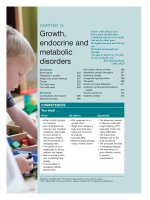Ebook Brain and behavior (5E): Part 1
Bạn đang xem bản rút gọn của tài liệu. Xem và tải ngay bản đầy đủ của tài liệu tại đây (12.42 MB, 685 trang )
Brain&Behavior
FifthEdition
ToDuejean
takenfromherfamilyandfriendsbyAlzheimer’sdisease.
—BobGarrett
Tomyfather
YouwerethesmartestmanI’veeverknown.Imissyoueveryday.
—GeraldHough
Brain&Behavior
AnIntroductiontoBehavioralNeuroscience
FifthEdition
BobGarrett
CaliforniaPolytechnicStateUniversity,SanLuis
Obispo
GeraldHough
RowanUniversity
Contributionsby
MeghanC.Kahn
IndianaUniversitySoutheast
JoshuaS.Rodefer
ValdostaStateUniversity
FORINFORMATION:
SAGEPublications,Inc.
2455TellerRoad
ThousandOaks,California91320
E-mail:
SAGEPublicationsLtd.
1Oliver’sYard
55CityRoad
LondonEC1Y1SP
UnitedKingdom
SAGEPublicationsIndiaPvt.Ltd.
B1/I1MohanCooperativeIndustrialArea
MathuraRoad,NewDelhi110044
India
SAGEPublicationsAsia-PacificPte.Ltd.
3ChurchStreet
#10-04SamsungHub
Singapore049483
Copyright©2018bySAGEPublications,Inc.
Allrightsreserved.Nopartofthisbookmaybereproducedorutilizedinany
formorbyanymeans,electronicormechanical,includingphotocopying,
recording,orbyanyinformationstorageandretrievalsystem,without
permissioninwritingfromthepublisher.
PrintedinCanada
Coverandtitlepageimage:©iStock.com/Krle
ISBN978-1-5063-4920-6
Thisbookisprintedonacid-freepaper.
AcquisitionsEditor:AbbieRickard
ContentDevelopmentEditor:LucyBerbeo
EditorialAssistant:JenniferCline
ProductionEditors:DavidC.Felts,KellyDeRosa
CopyEditor:AmyMarks
Typesetter:C&MDigitals(P)Ltd.
Proofreaders:LawrenceW.Baker,ScottOney
Indexer:DiggsPublicationServices
CoverDesigner:GailBuschman
MarketingManager:KatherineHepburn
BriefContents
Preface
AbouttheAuthors
Chapter1•WhatIsBehavioralNeuroscience?
PartI.NeuralFoundationsofBehavior:TheBasicEquipment
Chapter2•CommunicationWithintheNervousSystem
Chapter3•TheOrganizationandFunctionsoftheNervousSystem
Chapter4•TheMethodsandEthicsofResearch
PartII.MotivationandEmotion:WhatMakesUsGo
Chapter5•Drugs,Addiction,andReward
Chapter6•MotivationandtheRegulationofInternalStates
Chapter7•TheBiologyofSexandGender
Chapter8•EmotionandHealth
PartIII.InteractingWiththeWorld
Chapter9•HearingandLanguage
Chapter10•VisionandVisualPerception
Chapter11•TheBodySensesandMovement
PartIV.ComplexBehavior
Chapter12•LearningandMemory
Chapter13•IntelligenceandCognitiveFunctioning
Chapter14•PsychologicalDisorders
Chapter15•SleepandConsciousness
Glossary
References
AuthorIndex
SubjectIndex
DetailedContents
Preface
AbouttheAuthors
Chapter1•WhatIsBehavioralNeuroscience?
TheOriginsofBehavioralNeuroscience
PrescientificPsychologyandtheMind-BrainProblem
DescartesandthePhysicalModelofBehavior
HelmholtzandtheElectricalBrain
TheLocalizationIssue
NatureandNurture
TheGeneticCode
TheHumanGenomeProject
Application|ThePromiseofDNAComputing
Heredity:DestinyorPredisposition?
RESEARCHSPOTLIGHT|BeyondtheHumanGenomeProject
PartI.NeuralFoundationsofBehavior:TheBasicEquipment
Chapter2•CommunicationWithintheNervousSystem
TheCellsThatMakeUsWhoWeAre
Neurons
Application|TargetingIonChannels
GlialCells
HowNeuronsCommunicateWithEachOther
ChemicalTransmissionattheSynapse
INTHENEWS|RamónyCajal’sWorkReceivedbyNew
Audience
RegulatingSynapticActivity
Neurotransmitters
NeuralCodesandNeuralNetworks
Application|AgonistsandAntagonistsintheRealWorld
RESEARCHSPOTLIGHT|DHAforaBetterBrain
Chapter3•TheOrganizationandFunctionsoftheNervousSystem
TheCentralNervousSystem
TheForebrain
Application|TheCaseofPhineasGage
TheMidbrainandHindbrain
TheSpinalCord
ProtectingtheCentralNervousSystem
ThePeripheralNervousSystem
TheCranialNerves
TheAutonomicNervousSystem
DevelopmentandChangeintheNervousSystem
TheStagesofDevelopment
HowExperienceModifiestheNervousSystem
INTHENEWS|BreastmilkConsumptionIsGoodfortheBrain
DamageandRecoveryintheCentralNervousSystem
Application|UltrasoundSurgery
RESEARCHSPOTLIGHT|MendingtheBrainWithComputer
Chips
Chapter4•TheMethodsandEthicsofResearch
Science,Research,andTheory
TheoryandTentativenessinScience
ExperimentalVersusCorrelationalStudies
ResearchTechniques
StainingandImagingNeurons
LightandElectronMicroscopy
MeasuringandManipulatingBrainActivity
RESEARCHSPOTLIGHT|LookingIntotheBrain
INTHENEWS|PortableEEGRevealsReal-LifeBrainActivity
BrainImagingTechniques
Application|ScanningKingTut
RESEARCHSPOTLIGHT|GrowingaModelBrainFromSkin
Cells
InvestigatingHeredity
RESEARCHSPOTLIGHT|TheBrainbowConnection
ResearchEthics
PlagiarismandFabrication
ProtectingtheWelfareofResearchParticipants
GeneTherapy
StemCellTherapy
PartII.MotivationandEmotion:WhatMakesUsGo
Chapter5•Drugs,Addiction,andReward
PsychoactiveDrugs
Opiates
Depressants
Application|GovernmentAgenciesActtoCurbOverdoseDeaths
Application|TheAuto-BrewerySyndrome
Stimulants
Psychedelics
Marijuana
Application|ChangingAttitudesTowardMarijuana
Addiction
TheNeuralBasisofReward
TheNeuralBasisofAddiction
BrainPlasticityandLearninginAddiction
TreatingDrugAddiction
INTHENEWS|TargetingtheBraintoLessenDrugWithdrawal
TheRoleofGenesinAddiction
SeparatingGeneticandEnvironmentalInfluences
WhatIsInherited?
ImplicationsofAddictionResearch
Chapter6•MotivationandtheRegulationofInternalStates
MotivationandHomeostasis
TheoreticalApproachestoMotivation
SimpleHomeostaticDrives
Hunger:AComplexDrive
Gustation:TheRoleofTaste
Application|PredatorControlThroughLearnedTasteAversion
DigestionandtheTwoPhasesofMetabolism
SignalsThatStartaMeal
SignalsThatEndaMeal
Long-TermControls
Obesity
ResearchSpotlight|HowNicotineandMarijuanaAffectAppetite
ResearchSpotlight|Diabetes,theDuck-BilledPlatypus,andthe
ConeSnail
TheMythsofObesity
TheContributionsofHeredityandEnvironment
Application|TheSweetTasteofObesity
ObesityandReducedMetabolism
TreatingObesity
INTHENEWS|PetsMayProvideProtectionAgainstObesity
Anorexia,Bulimia,andBingeEatingDisorder
EnvironmentalandGeneticContributions
TheRoleofSerotonin,Dopamine,andCannabinoids
Chapter7•TheBiologyofSexandGender
SexasaFormofMotivation
ArousalandSatiation
TheRoleofTestosterone
BrainStructuresandNeurotransmitters
Odors,Pheromones,andSexualAttraction
Application|OfLove,Bonding,andEmpathy
TheBiologicalDeterminationofSex
ChromosomesandHormones
PrenatalHormonesandtheBrain
Gender-RelatedBehavioralandCognitiveDifferences
SomeDemonstratedMale-FemaleDifferences
OriginsofMale-FemaleDifferences
INTHENEWS|GTExProjectProvidesNewInsightIntothe
DifferencesBetweentheSexes
BiologicalOriginsofGenderIdentity
GenderDysphoria
46XYDifferenceinSexualDevelopment
46XXDifferenceinSexualDevelopment
CognitiveandBehavioralEffects
Application|Sex,Gender,andSports
AblatioPenisandOtherNaturalExperiments
SexualOrientation
Application|WhoChoosesaChild’sSex?
TheSocialInfluenceHypothesis
GeneticandEpigeneticInfluences
PrenatalInfluencesonBrainStructureandFunction
SocialImplicationsoftheBiologicalModel
Chapter8•EmotionandHealth
EmotionandtheNervousSystem
AutonomicandMuscularInvolvementinEmotion
TheEmotionalBrain
INTHENEWS|EmotionalProcessingDiffersbyClass
Application|WhyBobDoesn’tJumpOutofAirplanes
Stress,Immunity,andHealth
StressasanAdaptiveResponse
NegativeEffectsofStress
Social,Personality,andGeneticFactors
RESEARCHSPOTLIGHT|OneAftermathofDisasterIsStress-
RelatedBrainDamage
PainasanAdaptiveEmotion
BiologicalOriginsofAggression
TheBrain’sRoleinAggression
RESEARCHSPOTLIGHT|ABugThatCausesRoadRage?
HormonesandNeurotransmittersinAggression
Application|Neurocriminology,Responsibility,andtheLaw
HeredityandEnvironment
PartIII.InteractingWiththeWorld
Chapter9•HearingandLanguage
Hearing
TheAdequateStimulusforHearing
TheAuditoryMechanism
FrequencyAnalysis
RestoringHearing
RESEARCHSPOTLIGHT|BeyondCochlearImplants
AnalyzingComplexSounds
LocatingSounds
Application|IHearaTreeOverThere
Language
Broca’sArea
Wernicke’sArea
TheWernicke-GeschwindModel
Reading,Writing,andTheirImpairments
RecoveryFromAphasiaandLateralizationofLanguage
ALanguage-GeneratingMechanism?
INTHENEWS|LearnaNewLanguageWhileYouStudy
Psychology
LanguageinNonhumanAnimals
NeuralandGeneticAntecedents
INTHENEWS|LanguageDialects:YouAreFromWhatYou
Say
Chapter10•VisionandVisualPerception
LightandtheVisualApparatus
TheVisibleSpectrum
TheEyeandItsReceptors
PathwaystotheBrain
ColorVision
Application|RestoringLostVision
TrichromaticTheory
OpponentProcessTheory
ACombinedTheory
ColorBlindness
INTHENEWS|BeingaColor-BlindSportsFan
FormVision
ContrastEnhancementandEdgeDetection
Application|NeuralBasesofVisualIllusions
HubelandWiesel’sTheory
SpatialFrequencyTheory
ThePerceptionofObjects,Color,andMovement
TheTwoPathwaysofVisualAnalysis
DisordersofVisualPerception
TheProblemofFinalIntegration
RESEARCHSPOTLIGHT|WhenBindingGoesTooFar
Chapter11•TheBodySenseandMovement
TheBodySenses
Proprioception
TheSkinSenses
TheVestibularSense
TheSomatosensoryCortexandthePosteriorParietalCortex
PainandItsDisorders
Movement
TheMuscles
Application|TreatingPaininLimbsThatAren’tThere
TheSpinalCord
TheBrainandMovement
RESEARCHSPOTLIGHT|Brain-ComputerInterfaces
DisordersofMovement
Application|DeepBrainStimulationandParkinson’sDisease
PartIV.ComplexBehavior
Chapter12•LearningandMemory
LearningastheStorageofMemories
Amnesia:TheFailureofStorageandRetrieval
MechanismsofConsolidationandRetrieval
Application|TheLegacyofHM
WhereMemoriesAreStored
TwoKindsofLearning
WorkingMemory
BrainChangesinLearning
Long-TermPotentiation
HowLTPHappens
ConsolidationandSleep
ChangingOurMemories
Application|TotalRecall
INTHENEWS|EnhancingSoldiers’LearningWith
Neurostimulation
LearningDeficienciesandDisorders
EffectsofAgingonMemory
Alzheimer’sDisease
RESEARCHSPOTLIGHT|Alzheimer’sinaDish
KorsakoffSyndrome
Chapter13•IntelligenceandCognitiveFunctioning
TheNatureofIntelligence
WhatDoes“Intelligence”Mean?
TheStructureofIntelligence
TheBiologicalOriginsofIntelligence
TheBrainandIntelligence
SpecificAbilitiesandtheBrain
RESEARCHSPOTLIGHT|WeAren’ttheOnlyToolUsers
HeredityandEnvironment
Application|EnhancingIntelligenceandCognitivePerformance
DeficienciesandDisordersofIntelligence
EffectsofAgingonIntelligence
IntellectualDisability
AutismSpectrumDisorder
INTHENEWS|ZikaVirusImpactsNeuralDevelopment
Application|ChildhoodVaccinesandAutism
Attention-Deficit/HyperactivityDisorder
Chapter14•PsychologicalDisorders
Schizophrenia
CharacteristicsoftheDisorder
Heredity
TwoKindsofSchizophrenia
TheDopamineHypothesis
BeyondtheDopamineHypothesis
RESEARCHSPOTLIGHT|AntipsychoticsandTheirSide
Effects
BrainAnomaliesinSchizophrenia
AffectiveDisorders
Heredity
TheMonoamineHypothesisofDepression
Application|TargetingDrugstoSpecificReceptors
ElectroconvulsiveTherapy
Antidepressants,ECT,andNeuralPlasticity
RhythmsandAffectiveDisorders
BipolarDisorderandRelatedDisorders
BrainAnomaliesinAffectiveDisorders
Suicide
Anxiety,Trauma,andStress-RelatedDisorders
Heredity
INTHENEWS|HeightenedSuicideRiskAfterConcussion
GeneralizedAnxiety,PanicDisorder,andPhobia
PosttraumaticStressDisorder
AnomaliesinBrainFunctioning
PersonalityDisorders
Obsessive-CompulsiveDisorder
OCD-RelatedDisorders
Application|OfHermitsandHoarders
BorderlinePersonalityDisorder
Chapter15•SleepandConsciousness
SleepandDreaming
CircadianRhythms
RhythmsDuringWakingandSleeping
TheFunctionsofSleep
Sleep,Plasticity,andMemory
BrainStructuresofSleepandWaking
SleepDisorders
Application|IntheStilloftheNight
SleepasaFormofConsciousness
TheNeuralBasesofConsciousness
NetworkExplanationsofConsciousness
Awareness
Attention
Application|DeterminingConsciousnessWhenItCounts
TheSenseofSelf
INTHENEWS|LSDProvidesNewInsightsIntoConsciousness
Glossary
References
AuthorIndex
SubjectIndex
Preface
AMessageFromtheAuthors
Anyonewhostopslearningisold,whetherattwentyoreighty.Anyonewho
keepslearningstaysyoung.Thegreatestthinginlifeistokeepyourmind
young.
—HenryFord
Flipthroughthisbookandyou’llseethatitspagesarechock-fulloffactsand
applications—justasamplinggleanedfromavastsupplythatgrowstoofastfor
anyofustokeepupwithandthatbecomesobsoletejustasfast.Butsifting
throughthosefactsandreportingthemisneitherthemostdifficultnorthemost
importantfunctionofagoodtextbook.Agreaterchallengeisthatmoststudents
failtosharetheirinstructors’infatuationwithlearning;perhapstheylackthe
genes,ortheparentalrolemodels,orjusttheideathatlearningcanbefun.At
anyrate,theycanfindatextlikethisintimidating,anditisthetextbook’sroleto
changetheirminds.
Thecolorfulillustrations,casestudies,andresearchvignettesmaycapture
students’interest,butsparkinginterestaloneisnotenough.That’swhywe’ve
adoptedabig-pictureapproachinwritingthetext,onethatmarshalsfactsinto
explanationsanddiscardstheonesleftstandingaroundwithnothingtodo.
Whenyouputfactstoworkthatway,youbegintoseestudentslookupandsay,
“Thatmakessense,”or“I’vealwayswonderedaboutthat,butIneverthoughtof
itthatway,”or“NowIunderstandwhatwasgoingonwithUncleEdgar.”
Webelieveeducationhasthecapacitytomakeapersonhealthy,happy,and
productive,anditmakesasocietystrong.Educationrealizesthatpromisewhen
itleadspeopletoinquireandtoquestion,whentheylearnhowtolearn.When
45%ofthepublicbelievesinghosts,andpoliticshasbecomeagameplayedby
shoutingtheloudestortellingthemostconvincinglie,educationmorethanever
needstoteachyoungpeopletoask,“Whereistheevidence?”and“Isthatthe
onlypossibleinterpretation?”
Tothosewhowouldteachandthosewhowouldlearn,thisbookisforyou.
TotheStudent
Brain&Behaviorisourattempttoreachouttostudents,tobeckonthemintothe
fascinatingworldofbehavioralneuroscience.Theseareexceptionallyexciting
times,comparableinmanywaystotherenaissancethatthrustEuropefromthe
MiddleAgesintothemodernworld.AccordingtotheAmericanneurologist
StanleyB.Prusiner,
Neuroscienceisbyfarthemostexcitingbranchofsciencebecausethe
brainisthemostfascinatingobjectintheuniverse.Everyhumanbrainis
different—thebrainmakeseachhumanuniqueanddefineswhoheorshe
is.
Weknowofnoscientificdisciplinewithgreaterpotentialtoanswertheburning
questionsaboutourselvesthanbehavioralneuroscience.Wehopethistextbook
willconveythatkindofexcitementasyoureadaboutdiscoveriesthatwill
revolutionizeourunderstandingofwhatitmeanstobehuman.
Wewantyoutosucceedinthiscourse,but,morethanthat,wewantyoutolearn
morethanyoueverimaginedyoucouldandtogoawaywithanewappreciation
forthepromiseofbehavioralneuroscience.So,wehaveafewtipswewantto
passalong.First,trytositnearthefrontoftheclass,becausethosestudents
usuallygetthebestgrades.Thatisprobablybecausetheystaymoreengagedand
areencouragedtoaskmorequestions;buttoaskgoodquestions,youshould
alwaysreadthetextbeforeyougotoclass.Andsoyou’llknowwhereyou’re
goingbeforeyoubegintoread,takealookat“Afterreadingthischapter,you
willbeableto,”thenskimthechaptersubheadings,andreadthesummaryatthe
endofthechapter.Makesureyoucandefinetheterms,andvisualizethe
pathwaysandbrainareasasyoucomeacrossthem.Usethequestionsinthe
marginsasyougothroughthetext,answertheConceptCheckquestions,andbe
suretotestyourselfattheendusingtheTestYourUnderstandingquestions.As
youread,payspecialattentiontothetextinblue;thesearedefinitionsofthe
mostimportantterms,whicharedefinedagainintheglossaryattheendofthe
book.A“playbutton”iconliketheoneyouseeherewilltellyouwhichfigures
havebeenanimatedonthetext’swebsitetohelpsharpenyourunderstanding.
Then,don’tforgettolookupsomeofthebooksandarticlesinForFurther
Reading.Finally,carefullycuratedlistsofwebresourcesattheendofevery
chapterarefullyhyperlinkedontheStudentResourcessiteat
edge.sagepub.com/garrett5e,directingyoutoawealthofadditional
informationontheweb.Ifyouareconsideringacareerinbehavioral
neuroscience,makesureyoulookattheForFurtherThoughtquestionsatthe
endofeachchapter.Ifyoudoallofthesethings,youwon’tjustdobetterinthis
course;youwillleavesaying,“Ireallygotsomethingoutofthatclass!”And
whenit’stimetotaketheGRE(orMCATorVCAT),ortalktoyourdoctor,or
interviewforabiomedicaljob,orsimplyreadtheSciencesectionoftheNew
YorkTimes,you’llbeusingtheknowledgeyougainedinthistext.
StoriesofBrain&Behavior
WewroteBrain&Behaviorwithyouinmind,sowehopeyouwillletusknow
wherewehavedonethingsrightand,especially,wherewehavenot.Wewish
youthesatisfactionofdiscoveryandknowledgeasyoureadwhatwehave
writtenforyou.
TotheInstructor
WhenBobwrotethefirsteditionofBrain&Behavior,hehadonegoal:toentice
studentsintotheadventureofbehavioralneuroscience.Therewereothergood
textsoutthere,buttheyreadasthoughtheywerewrittenforstudentspreparing
forfurtherneurosciencecoursesingraduateschool.Thosestudentswillfindthis
bookadequatelychallenging,butBobwroteBrain&Behaviorsothatanyone
interestedinbehavior,includingthenewlydeclaredsophomoremajororthe
curiousstudentwhohaswanderedoverfromthehistorydepartment,canhave
thedeeperunderstandingthatcomesfromabiologicalperspectiveastheytake
othercoursesinpsychology.
Itisnotenoughtodrawstudentsinwithlivelywritingorbypiquingtheir
interestwithcasestudiesandtellinganoccasionalstoryalongtheway;unless
theyfeeltheyarelearningsomethingsignificant,theywon’tstay—they’lllook
forexcitementinmoretraditionalplaces.AsBobwrote,herememberedthetext
hestruggledwithinhisfirstbehavioralneuroscienceclass;itwasn’tvery
interestingbecauseneuroscientistsknewmuchlessaboutthebiological
underpinningsofbehaviorthantheydonow.Sincethattime,theyhavelearned
howthebrainchangesduringlearning,theyhavediscoveredsomeofthegenes
andbraindeficienciesthatcauseschizophrenia,andtheyarebeginningto
understandhowintricatenetworksofbraincellsproducelanguage,makeus
intelligent,andhelpusplaythepianoorfindamate.Inotherwords,behavioral
neurosciencehasbecomealotmoreinteresting.Sothematerialisthere;nowit
isourjobtocommunicatetheexcitementwehavefeltindiscoveringthesecrets
ofthebrainandtomakeaconvincingcasethatbehavioralneurosciencehasthe
powertoanswerstudents’questionsaboutbehavior.
Agoodtextbookisallaboutteaching,butthereisnoteachingifthereisno
learning.Overtheyears,ourstudentshavetaughtusagreatdealaboutwhatthey
neededtohelpthemlearn.Foronething,werealizedhowimportantitisfor
studentstobuildontheirknowledgethroughoutthecourse,sowehavemade
severalchangesfromtheorganizationofothertexts.First,thechapteron
neuronalphysiologyprecedesthechapteronthenervoussystem,becausewe
believethatyoucan’tbegintounderstandthebrainuntilyouknowhowits
neuronswork.Andwereversedtheusualorderofthevisionandaudition
chapters,becauseauditionprovidesafriendliercontextforintroducingthebasic
principlesofsensationandperception.Thechaptersonaddiction,motivation,
emotion,andsexfollowtheintroductiontoneurophysiology;thiswasdoneto
buildstudentmotivationbeforetacklingsensationandperception.Perhapsmore
significant,sometopicshavebeenmovedaroundamongchapterssothatthey
canbedevelopedinamorebehaviorallymeaningfulcontext.Sowediscuss
languagealongwithaudition,thebodysenseswiththemechanismsof
movement,thesenseoftasteinthecontextoffeedingbehavior,andolfactionin
conjunctionwithsexualbehavior.Mostunique,though,istheinclusionofa
chapteronthebiologyofintelligenceandanotheronconsciousness.Thelatteris
afulltreatmentofrecentdevelopmentsinthefield,ratherthanbeinglimitedto
theusualtopicsofsleepandsplit-brainbehavior.Thesetwochaptersstrongly
reinforcethethemethatbehavioralneuroscienceispersonallyrelevantand
capableofaddressingimportantquestions.
Brain&Behaviorhasseveralfeaturesthatwillmotivatestudentstolearnand
encouragethemtotakeanactiveroleintheirlearning.Itengagesthestudent
withinterest-grabbingopeningvignettes;illustrativecasestudies;andInthe
News,Application,andResearchSpotlightfeaturesthattakeanintriguingstep
beyondthechaptercontent.Throughouteachchapter,questionsinthemargins
keepthestudentfocusedonkeypoints,andaConceptCheckattheendofeach









